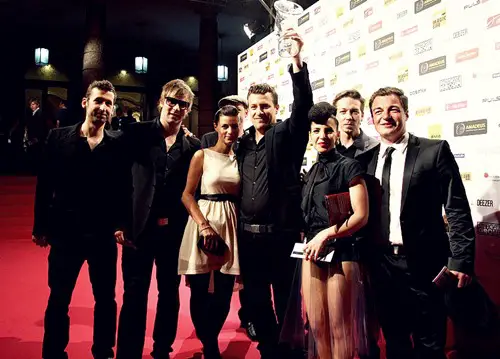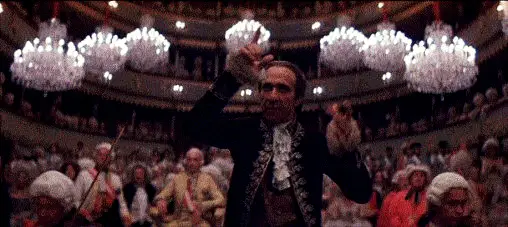
Presentation:
“Amadeus” (1984), coordinated by Milos Forman, is a realistic work of art that digs into the life and virtuoso of Wolfgang Amadeus Mozart. This widely praised film offers a captivating look into the universe of old style music and the perplexing connection among Mozart and his contemporary, Antonio Salieri. While “Amadeus” has earned far and wide acknowledgment, there are a few less popular realities about the film that might shock even its most impassioned fans. In this article, we investigate the main 10 less popular realities about “Amadeus” and shed light on the fascinating subtleties behind its creation.
Adjusted from a Play:
“Amadeus” was adjusted from a phase play of a similar name, composed by Peter Shaffer. Shaffer additionally wrote the screenplay for the film, guaranteeing that the embodiment of his unique work was safeguarded in the artistic variation.
The Salieri Fantasy:
The film sustains the legend that Antonio Salieri, a noticeable writer of the time, was liable for Mozart’s defeat. Actually, there is no substantial proof to help this case, and authentic records recommend that Salieri held extraordinary esteem for Mozart’s ability.
True Recording Areas:
“Amadeus” was fundamentally recorded on the spot in Prague, Czechoslovakia (presently the Czech Republic). The producers picked these areas to catch the design excellence and verifiable vibe of Mozart’s time.
Precise Period Ensembles:
The outfit plan in “Amadeus” is careful and well documented. The outfits were made with broad examination into eighteenth century design and are a visual banquet, submerging watchers in the lavishness of Mozart’s time.
A Shocking Soundtrack:

The film includes an exceptional soundtrack made out of Mozart’s most darling works, as well as unique pieces by Sir Neville Marriner. The music improves the profound profundity of the story and fills in as a demonstration of Mozart’s virtuoso.
Oscar Win:

Its prosperity at the Oscars is a demonstration of the film’s uncommon narrating, strong exhibitions, and magnificent execution.
At the 57th Institute Grants, “Amadeus” was designated for eleven classes, exhibiting its boundless effect across different parts of filmmaking. The film’s depiction of the extraordinary contention and complex connection between Wolfgang Amadeus Mozart and Antonio Salieri spellbound crowds and pundits the same. It deftly investigated topics of envy, virtuoso, and the quest for creative greatness, resounding with watchers on a significant close to home level. The film’s capacity to drench crowds in the realm of old style music and its assessment of the human condition moved it to the front of the honors season.
Chief Miloš Forman’s visionary narrating and fastidious scrupulousness were perceived with the Best Chief honor. His master heading brought the rich woven artwork of eighteenth century Vienna to life, catching the lavishness, wantonness, and imaginative enthusiasm of the time. Forman’s capacity to consistently mix show, humor, and melodic exhibitions made a convincing and vivid realistic experience.
The film’s champion exhibitions likewise assumed a critical part in its Oscar win. Tom Hulce’s groundbreaking depiction of Mozart procured him a selection for Best Entertainer, while F. Murray Abraham’s nuanced portrayal of Antonio Salieri gathered him a definitive acknowledgment, winning the Best Entertainer grant. Hulce’s exhibition caught the brightness, whimsy, and weakness of Mozart, while Abraham’s depiction breathtakingly conveyed Salieri’s struggle under the surface and fuming envy. Their exhibitions were a demonstration of their remarkable ability and devotion to rejuvenating these complicated characters.
“Amadeus” additionally got acknowledgment for its specialized accomplishments. The movie won grants for Best Workmanship Course, Best Outfit Plan, and Best Cosmetics, featuring the careful craftsmanship and meticulousness that brought the universe of Mozart and Salieri to the screen. The shocking visuals, elaborate period outfits, and complex set plans added to the film’s vivid and genuine depiction of eighteenth century Vienna.
The victory of “Amadeus” at the Oscars is a demonstration of its persevering through influence on the universe of film. Its acknowledgment across different classes represents the movie’s greatness in narrating, bearing, exhibitions, and specialized angles. The film’s capacity to spellbind crowds, incite thought, and get close to home reactions has cemented its place in film history. The Oscar win of “Amadeus” fills in as a demonstration of the force of film to move, rouse, and make a permanent imprint on the shared mindset of crowds and industry experts the same.
Verifiable Precision:
While the film is enlivened by verifiable occasions and figures, at last a work of fiction winds around a sensational story around the existences of these prestigious writers.
One of the main takeoffs from verifiable precision in “Amadeus” is the portrayal of the competition among Mozart and Salieri. While verifiable records propose that there might have been some expert contest and periodic hatred between the two writers, the extraordinary and all-consuming competition depicted in the film is generally a formation of the screenplay. The personality of Salieri is introduced as a scheming and wrathful bad guy, headed to obliterate Mozart out of jealousy and harshness. As a general rule, the connection among Mozart and Salieri was possible more mind boggling and nuanced, and there is no substantial proof to help the outrageous hostility portrayed in the film.
Moreover, “Amadeus” takes creative liberty with the depiction of Mozart’s personality, introducing him as an unendingly adolescent and youthful person. While Mozart was known for his lively and contemptuous character, the film misrepresents these qualities to the mark of cartoon. The film’s depiction of Mozart’s way of behaving and social collaborations, especially his cooperations with Head Joseph II, is intensely fictionalized for emotional impact.
Besides, the film’s portrayal of Mozart’s monetary battles and his sudden passing in destitution is likewise dependent upon verifiable hypothesis. While Mozart confronted monetary hardships during specific times of his life, the film presents a fairly misrepresented and distressing depiction of his conditions. Likewise, the conditions encompassing Mozart’s passing stay a subject of discussion among antiquarians, and the film’s understanding of his last minutes is a fictionalized sensation.
In spite of these takeoffs from authentic precision, perceiving the imaginative aims of the filmmakers is significant. “Amadeus” isn’t planned to be a narrative or a severe verifiable reenactment but instead a work of realistic narrating that investigates the subjects of virtuoso, desire, and the quest for creative greatness. The film involves verifiable figures as a springboard to dive into more profound philosophical and mental inquiries, taking artistic freedoms to make a convincing story.
All in all, while “Amadeus” is a work of art of film, it ought to be drawn nearer with a comprehension that it mistreats verifiable exactness. The film’s depiction of Mozart, Salieri, and their relationship is a fictionalized translation, and certain occasions and portrayals are sensationalized for creative impact. While the film may not stick rigorously to authentic reality, its effect lies in its capacity to charm crowds and incite thought and conversation about the idea of virtuoso and the intricacies of the human soul.
The Projecting Test:
Finding entertainers who could typify the enormous ability and mental profundity of these verifiable figures was quite difficult, and the projecting system assumed an essential part in the film’s prosperity.
The job of Mozart was eventually shared with entertainer Tom Hulce, whose projecting cocked eyebrows at that point. Hulce was principally known for his comedic jobs, and his choice as the splendid and tortured writer was met with suspicion by some. In any case, Hulce’s extraordinary presentation hushed skeptics, as he completely embraced the job and conveyed a depiction that oozed the unconventionality, energy, and weakness related with Mozart. Hulce’s obligation to catching the substance of the person, combined with his melodic preparation, permitted him to depict Mozart’s virtuoso and inner strife convincingly.
Similarly critical was the projecting of F. Murray Abraham as Antonio Salieri, Mozart’s desirous opponent. Abraham’s depiction of Salieri was a nuanced and enamoring portrayal of a complicated person consumed by jealousy and self-question. The projecting of Abraham, an entertainer known for his capacity to convey internal conflict and power, was instrumental in rejuvenating the struggle under the surface of Salieri. Abraham’s exhibition gathered basic recognition and procured him a Foundation Grant for Best Entertainer, hardening the giving choice a role as a stroke of splendor.
The projecting test stretched out past the two focal characters, with the whole troupe assuming a vital part in the film’s credibility and effect. Supporting entertainers, like Elizabeth Berridge as Constanze Mozart, Mozart’s better half, and Jeffrey Jones as Ruler Joseph II, added to the rich embroidery of the film’s reality. Their exhibitions added profundity to the connections and elements that molded the account.
Projecting for “Amadeus” was not exclusively founded on finding entertainers who looked like their genuine partners yet in addition on choosing people who could convey the close to home profundity and intricacies of the characters. projecting decisions by the movie producers were intense and unpredictable, testing the assumptions for crowds and industry standards. Nonetheless, their choices paid off, as the exhibitions of the cast individuals reinvigorated the verifiable figures and permitted watchers to interface with the characters on a significant level.
All in all, the projecting test looked by the producers of “Amadeus” was instrumental in bringing the characters of Mozart and Salieri to life. The choice of entertainers like Tom Hulce and F. Murray Abraham, who made heads spin and conveyed extraordinary exhibitions, assumed a vital part in the film’s prosperity. Their depictions, alongside the commitments of the supporting cast, added profundity and legitimacy to the story, making a sincerely resounding and enrapturing realistic experience. The projecting decisions made for “Amadeus” keep on being commended as a demonstration of the force of talented entertainers in rejuvenating verifiable figures on the big screen.
Dubious Chief’s Cut:
The dubious Chief’s Cut of “Amadeus” (1984), coordinated by Miloš Forman and composed by Peter Shaffer, ignited banter and partitioned crowds because of its adjusted account and extended running time. This variant of the movie, which was delivered quite a long while after the first dramatic delivery, offered an alternate point of view on the story and brought up issues about creative respectability and the effect of executive choices on the end result.
The Chief’s Cut of “Amadeus” broadened the film’s showing time to almost 20 minutes, considering the incorporation of extra scenes and subplots that were recently forgotten about. Quite possibly of the main change in the Chief’s Cut was the extended spotlight on the personality of Constanze Mozart, Wolfgang Amadeus Mozart’s significant other. The extra scenes shed light on her relationship with Mozart and her job in molding his profession. While certain watchers valued this more profound investigation of Constanze’s personality, others felt that the lengthy scenes disturbed the pacing and beat of the first film and reduced the focal account.
One more questionable part of the Chief’s Cut was the modified depiction of Antonio Salieri, the film’s hero and Mozart’s opponent. The lengthy rendition dug further into Salieri’s unseen conflicts and exhibited his developing fixation and jealousy towards Mozart. A few watchers felt that this extended portrayal added intricacy and profundity to Salieri’s personality, while others contended that it moved the concentrate away from Mozart and disturbed the equilibrium of the first film.
The Chief’s Cut likewise incorporated a questionable scene including the portrayal of Mozart’s entombment. In the first variant, Mozart’s body is matter-of-factly unloaded into a mass grave. Notwithstanding, the Chief’s Cut introduced an elective scene where Mozart is given a more stately and individual entombment. This deviation from verifiable precision ignited banter among watchers, with some contending that it sabotaged the brutal real factors of Mozart’s life and passing, while others valued the creative liberty taken to make an all the more genuinely effective second.
The arrival of the Chief’s Cut of “Amadeus” brought up issues about the job of the chief in forming the last vision of a film and the effect of their choices on the crowd’s understanding and experience. While certain watchers embraced the drawn out adaptation and valued the extra profundity and subtlety it brought to the characters and story, others found the progressions pointless and cheapening the first film’s effect.
Eventually, the dubious Chief’s Cut of “Amadeus” filled in as an impetus for conversations about imaginative decisions, story modifications, and the connection between chiefs, their works, and the crowd. It featured the abstract idea of film translation and the continuous discussion encompassing the benefits and outcomes of returning to and modifying finished films. Notwithstanding the contention, the Chief’s Cut of “Amadeus” stays a fascinating elective adaptation that keeps on powering talk among film aficionados and devotees of the first dramatic delivery.
Influence on Old style Music:
Through its convincing narrating and strong depiction of the confounding arranger, “Amadeus” engaged watchers as well as extended their appreciation for traditional music and Mozart’s virtuoso.
One of the outstanding effects of “Amadeus” was its capacity to refine Mozart, introducing him as an intricate and defective person instead of an unapproachable melodic god. The film digs into Mozart’s own battles, his struggles with power figures, and his steady quest for imaginative greatness. By depicting him as an interesting and multi-layered figure, “Amadeus” separated the legend encompassing Mozart and made him more open to crowds. This refinement of the writer started a reestablished interest in his life and music, as watchers associated with his energy, weaknesses, and imaginative splendor.
Besides, “Amadeus” exhibited Mozart’s music in a strong and dynamic manner, implanting it with sensational energy and profound reverberation. The film highlights famous sytheses by Mozart, for example, his Ensemble No. 25, Composition Mass in D minor, and The Marriage of Figaro, among others. The consideration of these magnum opuses in the film’s story highlighted their creative importance as well as acquainted them with a more extensive crowd. The splendid exhibitions and masterfully created scenes that displayed the music’s power and magnificence left an enduring effect on watchers, moving them to investigate Mozart’s broad collection and dig further into old style music all in all.
Notwithstanding its effect on Mozart’s music, “Amadeus” likewise shed light on the intricate elements of the traditional music world during Mozart’s time. The film investigated the connections between arrangers, supporters, and artists, featuring the battles, contentions, and legislative issues that molded the music scene of the eighteenth hundred years. By introducing this verifiable setting, “Amadeus” engaged as well as instructed watchers, furnishing them with a more profound comprehension of the difficulties looked by writers of the time and the cultural impacts that formed their music.
By and large, “Amadeus” fundamentally affected traditional music by promoting the life and music of Wolfgang Amadeus Mozart, refining the writer, and encouraging a reestablished interest in his works. Through its convincing narrating, strong exhibitions, and talented mix of Mozart’s music, the film enthralled crowds and developed their appreciation for the ageless virtuoso of one of traditional music’s most noteworthy writers. “Amadeus” keeps on being praised as a magnum opus that made a permanent imprint on both the entertainment world and the universe of old style music.
End:
“Amadeus” (1984) stays a true to life pearl that enraptures crowds with its investigation of Mozart’s virtuoso and the mind boggling elements of his time. The main 10 less popular realities about the film, including its variation from a play, the legend encompassing Salieri, legitimate shooting areas, and indisputable outfits, add profundity to our comprehension and enthusiasm for this striking work. As we keep on praising the tradition of Mozart, “Amadeus” remains as a demonstration of the getting through force of his music and the effect of his virtuoso on the universe of craftsmanship and culture.

